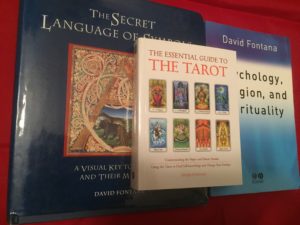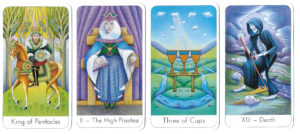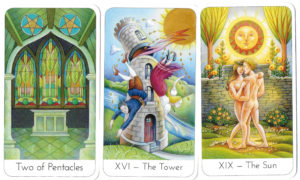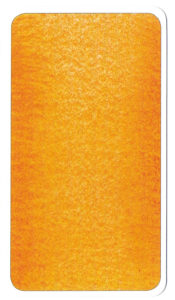The Wisdom Seeker’s Tarot
Posted by: The Tarosophist on: March 5, 2017
- In: Deck Reviews | Featured | Latest Decks
- Comment!
Originally published as The Truth Seeker’s Tarot in 2008 by Watkins, this deck has been re-issued as The Wisdom Seeker’s Tarot in 2017, after the authors death in 2010 following a short illness. David Fontana (1934 – 2010) was a widely-published author with over forty-five published works, including Psychology, Religion, and Spirituality (2003) and The Meditators Handbook (2002). He also published on dream symbolism, Zen, time management and earlier works such as Managing Classroom Behaviour (1986 & 1994).
He was foremost a psychologist, being Professor of Psychology at the University of Cardiff and visiting professor of two other universities – and one whom (in 1996) had helped create a transpersonal psychology section within the British Psychological Society. He was also a past-president of the Society for Psychical Research (SPR).
He saw both academic and mystical worlds as ultimately unified; in an interview, he spoke of Pythagoras, noting “‘Today he is only taught as a discoverer of a particular theorem, but Pythagoras also had a mystery school. It gave people access to deeper awareness through a variety of mediums, including sacred geometryâ€.
http://www.maggiehamilton.org/inconversation/david.htm
The artwork of the deck took over a year to produce and was created by “commissioned artist†Sylvie Daigneault, originally from Montreal, an artist, illustrator of children’s books (as was Pamela Colman Smith) and former dance group performer.
http://www.sylviedaigneault.com/
The first thing to say about the deck is that the text which accompanies it – both as the short seventy-eight-page booklet in the boxed set or the original (and much more detailed) The Essential Guide to the Tarot (Watkins, 2011) is that the correspondences for Wands and Swords are given as Air and Fire, respectively – the opposite to the common system derived from the Golden Dawn.
However – the artwork does not seem to reflect this version of the correspondence, and there is a piece of text in the Essential Guide where the elements and quarters are both listed after each other, in the order which would indicate the usual correspondences.
We have examined both works, and other works on symbolism by Fontana, and cannot find any indication that the switch was either deliberate or would indicate a confusion in the original text – which has been passed onto the new version. The example readings mainly use major arcana, and where the Wands or Swords are referenced, there is no indication of their elemental correspondence.
There is a note that the Six of Swords relates to the six-stage of the “rational and scientific fields for swordsâ€, which would usually lead us to equate Swords to Air through a correspondence of Air to thought, rationality and science.
Similarly, the artwork offers red as the predominant colour of the Wands, and yellow for Air, which are usually attributed to fire and air – the more common correspondence. If you did not have the text, we are sure most readers would not think the correspondence was meant to be anything other than the regular system.
This is a potential confusion which will remain unresolvable, as we discussed it with the publishers and they confirmed that the text in both books was from Fontana, and it is now impossible to clarify the original intention. It may be that the artist has design notes which would indicate the intention and the reasoning behind it, if it were deliberate.
It is a minor quibble (other than for an absolute beginner for whom it may be confusing) and brings us to consider the art of the deck and the utility of the accompanying booklet.
The Guidebook
We would certainly suggest picking up a second-hand copy of the more detailed Essential Guide to the Tarot (2011) as this provides more examples of the spreads and much more information on the symbology and variations of the cards to Waite-Smith, Thoth, Golden Dawn and Marseille decks. It is to be commended that the book provides a section on each variation, placing the design of the Major Arcana into a considered place within the tarot tradition – or traditions.
The artwork itself is instantly accessible and we would consider it ideal for beginners, particularly as it veers towards a Marseille-style décor on the Minor Arcana, proving a useful bridging deck between Marseille and Waite-Smith or other ‘scenic’ decks.
We would say it would make an ideal deck for younger beginners, given the style of illustration, however there are topless women (the four Princesses in particular) for which some adults may have consideration with regard to presenting them to younger readers.
Artwork & Symbolism
The deck is somewhat reminiscent of the Aquarian Tarot by David Palladini (US Games Systems, 1969) and the often maligned (wrongly, in our opinion) Tarot of the Witches (US Games Systems, 1991) designed by Fergus Hall, with whom the surrealistic elements of style are in common.
The Minor Arcana are styled as a Marseille deck but with scenic backgrounds and symbolism to convey the offered interpretation of the card. So, the Four of Cups shows a ship setting sail, carrying the four cups – which the booklet gives as “secrecy, depth, introversion …†which is not immediately obvious from the usual symbolic interpretation of a ship as voyaging, risk, trade and travel.
When we turn to the original book, we find the value of this card being more concisely “enterprise, depth†and the description stating clearly “the ships in this design symbolise that life is now reaching out to the wider world. This is a card of movement, at a steady, ordered pace, as signified by the stability of the number fourâ€. The book goes on with more detail and our recommendation is that anyone buying the deck ensures they get the original book to fully appreciate the design of the deck.
Another observation when we first looked through the deck was that the backgrounds were re-used in several cards. At first, we sought a pattern in this usage, as numerical patterns (especially pairs) are referenced in the book but when we enquired with the publisher they replied that the designs were chosen depending on the number and location of the cups, wands, swords, or pentacles on the card. So, we would not read too much into the choice of background in the minor arcana as a result.
The deck is perhaps more geared to self-development situations as certainly intended by the author – although oftentimes a deck can be perfectly used for “fortune telling†and predictive work even if it was designed as an intense Jungian analytical tool. Fontana states at the outset of the companion book:
“Tarot cards are best used to aid general self-development and inner growth rather than as a tool for fortune telling or for providing instruction about present or future actionsâ€.
Into the Structure of the Deck
The structure of the deck is worthy of some attention. As we commence with the Aces, Fontana develops the numerology of the deck when he states that they have “special significance as the number as both of the self, of our personal identity and of the unity that embraces all thingsâ€.
 The Aces are thus the “number of beginnings, of the first cause, of strength and of self-reliance, and of opening and awakeningâ€. He stresses that we are all individual, yet part of the whole “individuality and unity “are paradoxical, the one cannot exist without the other.
The Aces are thus the “number of beginnings, of the first cause, of strength and of self-reliance, and of opening and awakeningâ€. He stresses that we are all individual, yet part of the whole “individuality and unity “are paradoxical, the one cannot exist without the other.
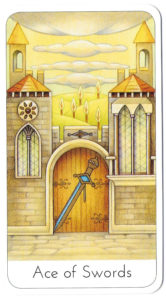 In the image of the Ace of Swords we are presented a gate-house and fixed upon the gate is a lone Sword. It crosses the door, the door through which “you can enter and exit at will.†The Aces psychologically and cosmically represent “the creative principle of the universe and thus denote absolute consciousnessâ€. We might even consider the Fool’s journey extended into the minor Arcana, where those who pass through these gates of the Aces commence the circular journey of existence. The view through the gate shows a tree-lined valley and beyond hangs a sky, pregnant with heavy lenticular cloud.
In the image of the Ace of Swords we are presented a gate-house and fixed upon the gate is a lone Sword. It crosses the door, the door through which “you can enter and exit at will.†The Aces psychologically and cosmically represent “the creative principle of the universe and thus denote absolute consciousnessâ€. We might even consider the Fool’s journey extended into the minor Arcana, where those who pass through these gates of the Aces commence the circular journey of existence. The view through the gate shows a tree-lined valley and beyond hangs a sky, pregnant with heavy lenticular cloud.
Working through the cards, the Two of Swords shares the same mystical iconography of the cloud and the sun along with the Four, Five and Ten of Swords. These cards pair up with heavy lenticular cloud symbolism, and create a profound pattern which alternates between uncertainty and faith. In the realm of Swords, we are constantly striving to rebalance our state between two edges of consciousness.
It struck us that the Five of Swords has a peculiar feel of mysticism to it, perhaps of the religious iconography such as illustrated by Wilfred Pippet, who illustrated two of the alternative Waite-Trinick tarot images. We see the sun, masked by clouds, streaming out in all directions and two doves meeting at either side of the sun. These symbolise a coming together, a reconciliation or union, but for there to be union there must first be a splitting asunder – an unrest or a state of limbo.
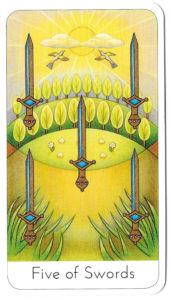 This state is found in the Five of Swords, where it is caught in the journey between Ace and Ten. This could be a traveller on a spiritual journey. Fontana wrote that the “Five of Swords is said to be a potentially unfortunate card, highlighting either possible danger or the need for protection.†It hints at the truth that it is when we are only half-way in any journey, be it a physical process that we are going through or a spiritual/emotional one it is often then we lose our way and fall into a chasm of indecision.
This state is found in the Five of Swords, where it is caught in the journey between Ace and Ten. This could be a traveller on a spiritual journey. Fontana wrote that the “Five of Swords is said to be a potentially unfortunate card, highlighting either possible danger or the need for protection.†It hints at the truth that it is when we are only half-way in any journey, be it a physical process that we are going through or a spiritual/emotional one it is often then we lose our way and fall into a chasm of indecision.
A Method of Using the Deck
We performed an initial reading with the cards using a tarosophy technique based on Kabbalah. We use this method to teach beginners and intermediate students a deep appreciation of the Tree of Life, without having to specifically learn Kabbalah – it is done through using their existing experience of tarot.
There are twenty-two variations of the method, one for each of the Major Arcana. Here we will use the Blasted Tower – which connects the two Sephiroth of Hod and Netzach on the Tree of Life.
We take the Blasted Tower out of the deck and place it on the table.
We consider a situation that is caught in a loop or cycle and one which we wish to change.
We shuffle the remaining deck and take out two cards, placing them (in this case) to the left and right of the Blasted Tower. You can take the top two cards, or one card from the top of the deck and the other card from the bottom, as feels best for you.
The card placed on the left shows our habitual thinking pattern about the situation.
The card on the right shows our ingrained emotional pattern.
Their relationship is through the Blasted Tower, and reading them together will suggest the change that we can best make now.
In this example reading we have the Two of Pentacles on the left and the Sun (XIX) to the right.
It signifies on one hand that “now that the one has become two and new beginnings are afoot, endings are also possible†(Essential Guide to the Tarot, Fontana, p. 191). This is in the realm of our habitual thinking. It seems that “a mysterious light floods the darkness†and that the balance that was sought has already started to change. Our thoughts have assumed that stability is possible when the situation is already split and change is underway.
On the other side of the Tower we see the Sun. The full text reads “each body is given to the other†in describing the integration and openness of this image. It shows that a certain journey is nearing its fulfilment and that the only remaining trial is of “surrender, not of effortâ€. The emotional side of this equation must be addressed by self-surrender to the authentic wholeness within oneself. As Fontana writes, “without this wholeness a person will remain alienated and a stranger even to themselves†(p. 126).
So, a powerful and profound reading, with deep significance. It also automatically installs an appreciation in the reader of the Sephiroth of Hod and Netzach on the Tree of Life and their relationship.
Cardstock: Glossy
Cardbacks: Orange Speckle pattern (reversible)
Borders: White, thin
Text: Modern font naming card in white banner at foot of each card.
Strength/Justice: VIII/XI
Court Naming: Princess, Prince, Queen, King
Note: In the first version of the deck (illustrating the original book), the Aces were called “The One of Swordsâ€, etc., but in this version, they are called “Acesâ€.
Summary
The Wisdom Seeker’s Tarot by David Fontana (pub. Watkins, 2017) is an interesting deck for beginners to intermediate readers who should decide about the correspondence issue of Swords and Wands. It is very accessible, friendly (considering topless female images) and the original guidebook is to be recommended in addition to the guidebook that accompanies the boxed set.
Search
- Veronique Coppin: could you please send me the link to download the companion book with extra information on the gilded reverie lenormand cards? It's no longer availab
- Conversation with Karen Lisa Salamon – Eng Agger · MA Fine Art Digital: […] card which he used to start his imagination. Dali read the cards; he saw signs. It is to find in “Tarot Universal Dali”. Seeing
- Deck Overview: The Steampunk Tarot – Deanna Discusses: […] Blog reviews: Aeclectic Tarot, New Paths Tarot, Perspectives on Tarot, Tarot Elements, and The Tarot Review […]
Categories
- Announcements (3)
- Book Reviews (1)
- Deck Reviews (18)
- Featured (22)
- Golden Oldies (3)
- Latest Decks (10)
- Sneak Peaks (6)
